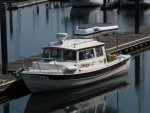You are using an out of date browser. It may not display this or other websites correctly.
You should upgrade or use an alternative browser.
You should upgrade or use an alternative browser.
A new twist on stopping fire. What do you think.
- Thread starter starcrafttom
- Start date
Interesting. I can see it having some applications (like fixed installations). One problem I see is what happens if you throw it at a fire and miss? You might not be able to retrieve it and try again.
If the fire is dispersed it might not be as effective as fire extinguisher that you can move around while discharging it.
Even though they show people holding one when it goes off, I'm not sure that I'd want to do that.
It also seems that you need a decent fire to get the thing to go off (either there is a fuse or the container bursts or melts when it gets hot enough). If you have a small fire it may not be large or hot enough to set the extinguisher off. I wonder if there is a way to manually discharge it.
If the fire is dispersed it might not be as effective as fire extinguisher that you can move around while discharging it.
Even though they show people holding one when it goes off, I'm not sure that I'd want to do that.
It also seems that you need a decent fire to get the thing to go off (either there is a fuse or the container bursts or melts when it gets hot enough). If you have a small fire it may not be large or hot enough to set the extinguisher off. I wonder if there is a way to manually discharge it.
Looks to be very effective. Not sure what would happen if you are in a confined space, when that goes off. I would be worried about inhalation effects--maybe OK if full pressure mask--not sure about just carbon filter type of mask.
From what I can find, it use an ammonia based powder extinguishing substance. There is a good write up on the Australian site (better than on us site:
http://elidefire.com.au/technical-details/
Not cheap: 3 / $229, Comes from some overseas supplier.
No evidence of certification for boats by USCG. Or by any Fire Marshall/fire inspection certification services in the US.
I sent the link to a good friend who is a retired Fire Chief--I always respect his thoughts.
There seem to be some knockoffs from China--but I would be suspicious of those. Maybe the real thing from China, at $30 each, but in large lots.
Considering that the patent was granted 12 years ago, there does not seem to be wide spread use in the US.
From what I can find, it use an ammonia based powder extinguishing substance. There is a good write up on the Australian site (better than on us site:
http://elidefire.com.au/technical-details/
Not cheap: 3 / $229, Comes from some overseas supplier.
No evidence of certification for boats by USCG. Or by any Fire Marshall/fire inspection certification services in the US.
I sent the link to a good friend who is a retired Fire Chief--I always respect his thoughts.
There seem to be some knockoffs from China--but I would be suspicious of those. Maybe the real thing from China, at $30 each, but in large lots.
Considering that the patent was granted 12 years ago, there does not seem to be wide spread use in the US.
AstoriaDave
New member
Not me. I have suppressed several solvent fires using various extinguishers, CO2, dry chemicsl, etc., and they all work, are controllable, and can be directed where you want them to go. On a boat, I want directional control to the max. Sure, for a house fire or dumpsters, I can see the value, especially for SCBA equipped and trained firefighters.
But tossing one of those into a cockpit, surrounded by open water? I don't think so.
In a boat, whether FRP, wood, or steel, I want good suppression, directed at the problem, with a known, safe exit at my back, ready to bail out if there is a hint of an out of control blaze.
But tossing one of those into a cockpit, surrounded by open water? I don't think so.
In a boat, whether FRP, wood, or steel, I want good suppression, directed at the problem, with a known, safe exit at my back, ready to bail out if there is a hint of an out of control blaze.
It looks "fun" and for some of those applications like engine room or computer room maybe. I agree, I like a controlled extinguisher, and I don't much like dry chemicals due to the corrosives. I think I will stick with my CO2. If I had a big boat with an engine room, I would be looking at a FLIR monitor and a halon or CO2 installation.
Harvey
SleepyC :moon

Harvey
SleepyC :moon

